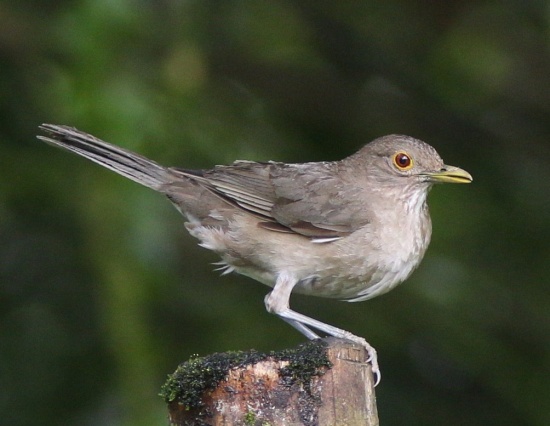- Turdus maculirostris
Identification
21·5–23 cm (8½-9 in)
Adult: olive-brown upperside, buffy-olive underside, white throat with pale stripes, legs grey and bill yellow (sometimes greenish or horn), and narrow orange (to yellow) ring of bare skin around eye.
Similar Species
Clay-colored Thrush and Spectacled Thrush
Distribution
South America: found from coastal and foothill Western Ecuador (Esmeraldas and Pichincha) to extreme north-western Peru (Tumbes).
Taxonomy.
This taxon has sometimes been lumped with Spectacled Thrush. With the recent acceptance of the split by SACC and Clements, there is now again majority for considering these two separate species.
Habitat
This is a forest specialist often found in primary forest (humid or deciduous), secondary forest, and less commonly in degraded areas, and if so prefers humid areas. Lowland forest and gardens.
Behaviour
Diet
Forages from canopy to mid height, and more rarely, on forest floor. There is little information available on their actual diet.
Breeding
The nest is a cup made from mud and moss.
References
- Clements, J. F., T. S. Schulenberg, M. J. Iliff, D. Roberson, T. A. Fredericks, B. L. Sullivan, and C. L. Wood. 2014. The eBird/Clements checklist of birds of the world: Version 6.9., with updates to August 2014. Downloaded from http://www.birds.cornell.edu/clementschecklist/download/
- SACC proposal to split Ecuadorian Thrush
- Restall et al. 2006. Birds of Northern South America. Yale University Press. ISBN 9780300124156
- Handbook of the Birds of the World Alive (retrieved August 2015)
Recommended Citation
- BirdForum Opus contributors. (2025) Ecuadorian Thrush. In: BirdForum, the forum for wild birds and birding. Retrieved 13 May 2025 from https://www.birdforum.net/opus/Ecuadorian_Thrush




